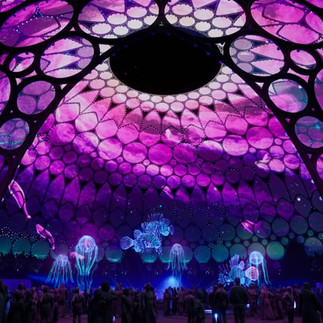The Metaverse isn't Dead. Think Different.
- Frank Verderosa
- Jun 3, 2023
- 5 min read
Updated: Sep 11, 2023

I’m writing this just ahead of Apple’s WWDC23 (June 5th, 2023), and those that watch Apple closely are hoping for an announcement on their long awaited VR/ augmented reality/ mixed reality headset. It’s interesting that the media landscape has been littered with articles crying “the death of the metaverse”, at the same time that Meta has announced their Quest 3, and others are set to launch their latest VR headset offerings.
So why are there suddenly so many articles proclaiming the death of the metaverse? The obvious answer is money. VR flourished during COVID lockdown, offering places for friends to gather to exercise, bowl, golf, play any number of immersive games, or just socialize during a time where we couldn’t be together (and we were tired of Zoom meetings). News reports today are about the decline in sales of those headsets as the world is opening back up. So why get excited about Apple’s potential foray into VR headsets?
In a Tik Tok video a while back, Gary Vaynerchuk spoke about the early days of the internet and trying to tell people that he would sell wine online. “Who would want to buy wine on the internet”, people asked. “Everyone!” he replied. People just didn’t understand it.
Back in the early 1990s while working for a music studio that often dealt with ad agencies, I said to my employer “wouldn’t it be great if instead of having a bike messenger waiting all day to bring tapes up to the client, we could just send audio like a fax?” He replied “it’s not possible. Too much data”.
In the late 90s when I owned and operated Planet V, I saw a demonstration from a company called Liquid Audio at an Audio Engineering Society convention in New York City. Their software, which I considered licensing, would allow me to make an MP3 audio file to email to clients for mix approvals. They would need to install a player with my company branding on the disc to listen back. This would be a tremendous advancement compared to listening over the phone, which was the order of the day. When I asked my clients what they thought of it, they unanimously agreed that there was no way a client would ever be able to figure this out.
Most recently, I suggested to a colleague that in VR, it’s entirely possible to replicate entire post production facilities so that clients could participate remotely while having a shared experience. You can sit in a replica of an edit suite or audio room and listen in, comment, and work together as we would in real life! Once again, the response was “never going to happen. The resolution isn’t there.”
All of the situations above share the same reception, based on what I consider to be a shortsighted lack of vision. People keep thinking in terms of NOW versus a few YEARS from now!
As Gary Vaynerchuk said in the video linked above, “We as human beings love NO and are scared of YES. We get comfortable, and we are unable to see the opportunity that is in front of us because of that fear of trying something else. To put in the extra work. To do the homework. To understand the new thing”.
Right now, if you were to put on an Meta Quest 2, you’d be experiencing a self contained processor generating entire worlds to explore. While it’s easy to relegate it to being a toy because games and experiences outnumber useable business applications today, that too would be shortsighted. In fact, I firmly believe that VR has a seat at the table when it comes to production- especially in remote and hybrid worlkflows.
Perhaps Apple’s entry into this arena will get more serious eyes on the prize. The rumored 8K resolution of their headsets would make for much more detailed, immersive experience that’s even richer and more vibrant than what the Quest 2 offers. Their push for mixed and augmented reality may be what’s needed to break through into a more acceptable and wearable device with better and more interactive solutions for business. With much higher screen resolutions, what you'll sees will likely rival your current Mac laptop screen- which people seem to readily accept for production decisions. Having a familiar, albeit virtual environment to collaborate in would offer a uniform workflow for a creative team, while the quality of an Apple display provides consistency.
Microsoft’s recently killed AltSpace platform put a spotlight on what’s possible, thanks to an endlessly talented and creative community of designers and developers. Entire malls and convention centers were built. Virtual concerts were attended. Karaoke nights were commonplace. Meetups with people around the world were constant. Everything from comedy clubs to churches existed in AltSpace!
A world that I had worked on and maintained in AltSpace, called Voice Actors in VR (built off of a space called ‘Andy’s High Rise’), was a museum-like gathering place where people could come together to socialize and learn. In addition to being an immersive show space for recording studio photos and other informative materials, it was a small glimpse into what’s possible. I could share classes via my Edge browser onto an enormous screen. Folks could gather and participate- asking questions avatar to avatar and interact with guests.
As proud as I was of my space, it pales in comparison to projects like the United Nations Act Now Virtual Reality experience, which recreated the Al Wasl Dome in Dubai to bring into existence an event that had been cancelled because of COVID. The design was off the charts, including a screen mapped video done with an immersive audio track and a global feel. The actual dome can be seen above left, while the VR version is on the right.
More recently, artist Fatboy Slim ran a series of VR rave events in Engage VR, which were absolutely stunning- and massive in scope. The event took participants on a journey through FatBoy Slim's music and mind that had multiple large crowds cheering hour after hour.
We don’t know when the next lockdown might happen. But for businesses to not explore VR in a meaningful way, and to simply buy into the idea that “the metaverse is dead” is not only ignorant- it’s wrong. Every big box store should have an immersive app allowing customers to experience their brand identity and products in a new and exciting way. To be able to walk around 3D scans of objects in a virtual store that can be added to a cart and delivered should be obvious. Branded content to make those virtual destinations a place worth revisiting could take an ordinary box store and turn it into a social experience. Virtual employees could be on hand to answer questions.
For my world as an audio mixer, having a virtual mix suite replicating the space we’d normally meet in is, for the most part, available today. Take it a step further and sit in a room with your production team to review edits on a big screen and make changes with your editor in real time. Review color grading sessions, graphics- literally anything you could do on-site… just by slapping on a pair of goggles and logging in.
It’s easy to take shots at people like Mark Zuckerberg and grab readers by claiming a new technology is dead on arrival. But- love him or hate him- he’s right on this one, and we’re all too ready to accept the opinions of those who lack vision and creativity.
The metaverse isn’t dead. It’s about to be born.


































Commenti